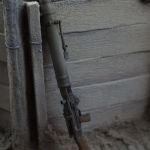







Single Lewis Machine Gun / Bt. Lewis Maschinengewehr (Tellergewehr)
- Scale / Maßstab: 1/16th (120mm)
- Material: Resin
- Parts / Teile: 8
- Infosheet / Infoblatt: English
- Code / Artikel-Nr.: IS20
- Attention: Not a toy. Model kit or model making accessories – not suitable for children under 14 years of age. / Achtung: Kein Spielzeug. Modellbauzubehör – nicht für Kinder unter 14 Jahren geeignet
GPSR Data / Angaben
- Manufacturer / Hersteller: Jon Smith Modellbau
- Responsible Person / Verantwortliche Person
- Address: Hannoverstr. 68, 29664 Walsrode, Germany
- Contact / Kontakt: info@jonsmith-modellbau.com
- Tel: +49 (0)5161 8255
Contents / Inhalte:
- Lewis Machine Gun (2 Parts) / Lewis Maschinengewehr (2 Teile)
- Bipod / Zweibein
- 2 x Drum Magazines / 2 x Trommelmagazinen
- 16 x Empty Cartridges / 16 x Leere Patronen
Lewis Gun: Originally designed by Samuel MacLean and then redesigned by Colonel Isaac Newton Lewis of the United States Coast Artillery. In 1913, after having the gun rejected by the US Army, Colonel Lewis set up production in a factory in Liege, Belgium. Before the Germans overran Belgium in 1914 the production was transferred to the Birmingham Small Arms Company in England. As both sides settled down to mainly four years of static trench warfare, a need for a light machine gun in the British Army became apparent. When introduced it was a welcomed addition to the infantryman’s firepower, even with its complex design and numerous different types of stoppages. The rotating magazine held 47 .303-inch rounds in two layers. When being carried on the shoulder the magazine was normally removed to allow the gun to sit more comfortably, closer to the centre of the body. The Germans used captured Lewis guns extensively, equipping infantry, Stormtrooper, MG Units and parts of their Musketen battalions – replacing the Danish Madsens. The guns were re-chambered to take the German 7.92 mm round and unofficially called Tellergewehr or plate rifle. Many German Units retained their Lewis guns, even after the introduction of Germany’s first light machine gun, the Maschinengewehr 08/15, which was somewhat cumbersome and noticeably heavier (17.7 Kg. to 12.25 Kg.). Colour: the wooden stock and pistol grips are of a dark wood. All other parts are a dark gun- metal.
Note: it is possible to hollow out the space between the rear sight and mount, as well as inside the forward sling attachment (under the barrel). The bipod legs should be fixed with the `spade´ like slats facing outwards away from the barrel and with the small wing nuts underneath. The magazine should / can rotate when placed on the gun.
 An deutschsprachige Interessenten:
Sie können mich per eMail oder Telefon auch gerne auf deutsch kontaktieren. Ortsbesuch ist nach Absprache möglich.
An deutschsprachige Interessenten:
Sie können mich per eMail oder Telefon auch gerne auf deutsch kontaktieren. Ortsbesuch ist nach Absprache möglich.
